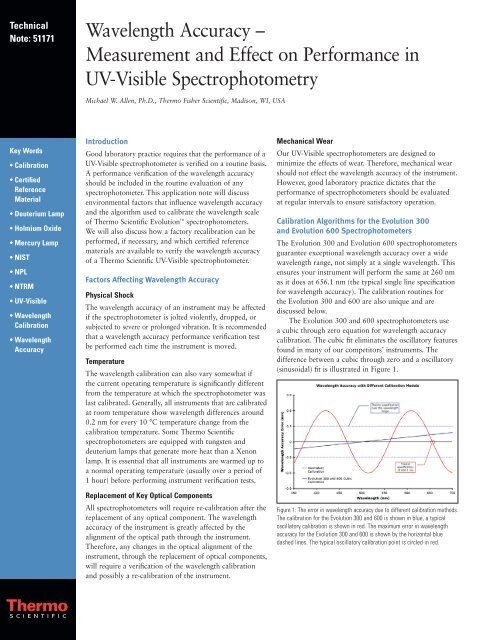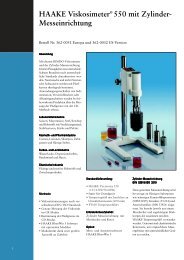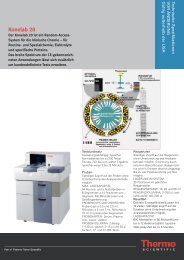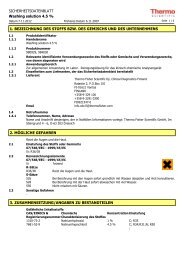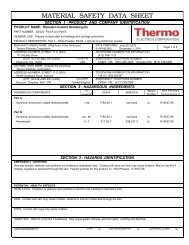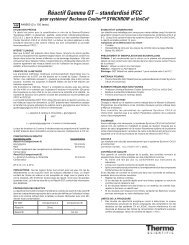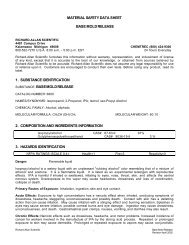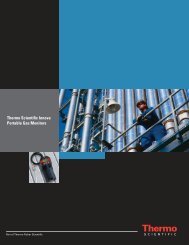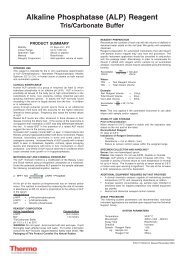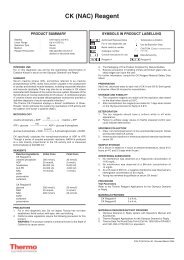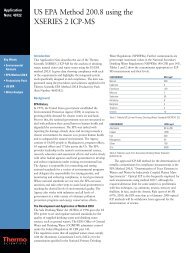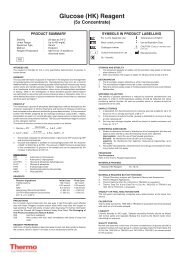Wavelength Accuracy â Measurement and Effect on ... - Sorvall
Wavelength Accuracy â Measurement and Effect on ... - Sorvall
Wavelength Accuracy â Measurement and Effect on ... - Sorvall
You also want an ePaper? Increase the reach of your titles
YUMPU automatically turns print PDFs into web optimized ePapers that Google loves.
Technical<br />
<str<strong>on</strong>g>Wavelength</str<strong>on</strong>g> <str<strong>on</strong>g>Accuracy</str<strong>on</strong>g> –<br />
Note: 51171<br />
<str<strong>on</strong>g>Measurement</str<strong>on</strong>g> <str<strong>on</strong>g>and</str<strong>on</strong>g> <str<strong>on</strong>g>Effect</str<strong>on</strong>g> <strong>on</strong> Performance in<br />
UV-Visible Spectrophotometry<br />
Michael W. Allen, Ph.D., Thermo Fisher Scientific, Madis<strong>on</strong>, WI, USA<br />
Key Words<br />
• Calibrati<strong>on</strong><br />
• Certified<br />
Reference<br />
Material<br />
• Deuterium Lamp<br />
• Holmium Oxide<br />
• Mercury Lamp<br />
• NIST<br />
• NPL<br />
• NTRM<br />
• UV-Visible<br />
• <str<strong>on</strong>g>Wavelength</str<strong>on</strong>g><br />
Calibrati<strong>on</strong><br />
• <str<strong>on</strong>g>Wavelength</str<strong>on</strong>g><br />
<str<strong>on</strong>g>Accuracy</str<strong>on</strong>g><br />
Introducti<strong>on</strong><br />
Good laboratory practice requires that the performance of a<br />
UV-Visible spectrophotometer is verified <strong>on</strong> a routine basis.<br />
A performance verificati<strong>on</strong> of the wavelength accuracy<br />
should be included in the routine evaluati<strong>on</strong> of any<br />
spectrophotometer. This applicati<strong>on</strong> note will discuss<br />
envir<strong>on</strong>mental factors that influence wavelength accuracy<br />
<str<strong>on</strong>g>and</str<strong>on</strong>g> the algorithm used to calibrate the wavelength scale<br />
of Thermo Scientific Evoluti<strong>on</strong> spectrophotometers.<br />
We will also discuss how a factory recalibrati<strong>on</strong> can be<br />
performed, if necessary, <str<strong>on</strong>g>and</str<strong>on</strong>g> which certified reference<br />
materials are available to verify the wavelength accuracy<br />
of a Thermo Scientific UV-Visible spectrophotometer.<br />
Factors Affecting <str<strong>on</strong>g>Wavelength</str<strong>on</strong>g> <str<strong>on</strong>g>Accuracy</str<strong>on</strong>g><br />
Physical Shock<br />
The wavelength accuracy of an instrument may be affected<br />
if the spectrophotometer is jolted violently, dropped, or<br />
subjected to severe or prol<strong>on</strong>ged vibrati<strong>on</strong>. It is recommended<br />
that a wavelength accuracy performance verificati<strong>on</strong> test<br />
be performed each time the instrument is moved.<br />
Temperature<br />
The wavelength calibrati<strong>on</strong> can also vary somewhat if<br />
the current operating temperature is significantly different<br />
from the temperature at which the spectrophotometer was<br />
last calibrated. Generally, all instruments that are calibrated<br />
at room temperature show wavelength differences around<br />
0.2 nm for every 10 °C temperature change from the<br />
calibrati<strong>on</strong> temperature. Some Thermo Scientific<br />
spectrophotometers are equipped with tungsten <str<strong>on</strong>g>and</str<strong>on</strong>g><br />
deuterium lamps that generate more heat than a Xen<strong>on</strong><br />
lamp. It is essential that all instruments are warmed up to<br />
a normal operating temperature (usually over a period of<br />
1 hour) before performing instrument verificati<strong>on</strong> tests.<br />
Replacement of Key Optical Comp<strong>on</strong>ents<br />
All spectrophotometers will require re-calibrati<strong>on</strong> after the<br />
replacement of any optical comp<strong>on</strong>ent. The wavelength<br />
accuracy of the instrument is greatly affected by the<br />
alignment of the optical path through the instrument.<br />
Therefore, any changes in the optical alignment of the<br />
instrument, through the replacement of optical comp<strong>on</strong>ents,<br />
will require a verificati<strong>on</strong> of the wavelength calibrati<strong>on</strong><br />
<str<strong>on</strong>g>and</str<strong>on</strong>g> possibly a re-calibrati<strong>on</strong> of the instrument.<br />
Mechanical Wear<br />
Our UV-Visible spectrophotometers are designed to<br />
minimize the effects of wear. Therefore, mechanical wear<br />
should not effect the wavelength accuracy of the instrument.<br />
However, good laboratory practice dictates that the<br />
performance of spectrophotometers should be evaluated<br />
at regular intervals to ensure satisfactory operati<strong>on</strong>.<br />
Calibrati<strong>on</strong> Algorithms for the Evoluti<strong>on</strong> 300<br />
<str<strong>on</strong>g>and</str<strong>on</strong>g> Evoluti<strong>on</strong> 600 Spectrophotometers<br />
The Evoluti<strong>on</strong> 300 <str<strong>on</strong>g>and</str<strong>on</strong>g> Evoluti<strong>on</strong> 600 spectrophotometers<br />
guarantee excepti<strong>on</strong>al wavelength accuracy over a wide<br />
wavelength range, not simply at a single wavelength. This<br />
ensures your instrument will perform the same at 260 nm<br />
as it does at 656.1 nm (the typical single line specificati<strong>on</strong><br />
for wavelength accuracy). The calibrati<strong>on</strong> routines for<br />
the Evoluti<strong>on</strong> 300 <str<strong>on</strong>g>and</str<strong>on</strong>g> 600 are also unique <str<strong>on</strong>g>and</str<strong>on</strong>g> are<br />
discussed below.<br />
The Evoluti<strong>on</strong> 300 <str<strong>on</strong>g>and</str<strong>on</strong>g> 600 spectrophotometers use<br />
a cubic through zero equati<strong>on</strong> for wavelength accuracy<br />
calibrati<strong>on</strong>. The cubic fit eliminates the oscillatory features<br />
found in many of our competitors’ instruments. The<br />
difference between a cubic through zero <str<strong>on</strong>g>and</str<strong>on</strong>g> a oscillatory<br />
(sinusoidal) fit is illustrated in Figure 1.<br />
Figure 1: The error in wavelength accuracy due to different calibrati<strong>on</strong> methods.<br />
The calibrati<strong>on</strong> for the Evoluti<strong>on</strong> 300 <str<strong>on</strong>g>and</str<strong>on</strong>g> 600 is shown in blue, a typical<br />
oscillatory calibrati<strong>on</strong> is shown in red. The maximum error in wavelength<br />
accuracy for the Evoluti<strong>on</strong> 300 <str<strong>on</strong>g>and</str<strong>on</strong>g> 600 is shown by the horiz<strong>on</strong>tal blue<br />
dashed lines. The typical oscillatory calibrati<strong>on</strong> point is circled in red.
In Figure 1, the error in wavelength accuracy for the<br />
Evoluti<strong>on</strong> 300 <str<strong>on</strong>g>and</str<strong>on</strong>g> 600 instruments is represented by the<br />
solid blue line. The horiz<strong>on</strong>tal, dashed blue lines represent<br />
the wavelength accuracy specificati<strong>on</strong> of the Evoluti<strong>on</strong> 300<br />
<str<strong>on</strong>g>and</str<strong>on</strong>g> 600 instruments. Note that the typical oscillatory<br />
calibrati<strong>on</strong> has wavelength calibrati<strong>on</strong> errors that fall outside<br />
our Evoluti<strong>on</strong> spectrophotometer specificati<strong>on</strong>s. The<br />
oscillatory calibrati<strong>on</strong> is designed to have a minimum error<br />
at a single calibrati<strong>on</strong> point, usually the 656.1 nm deuterium<br />
line. This translates into essentially low error at this single<br />
wavelength, but much larger error values elsewhere, for<br />
example 510 or 600 nm, as shown in Figure 1.<br />
Performing a Factory Re-calibrati<strong>on</strong><br />
Using a Mercury Lamp Accessory<br />
The Mercury Lamp accessory gives you ability to perform<br />
the exact same calibrati<strong>on</strong> that was performed <strong>on</strong> your<br />
Evoluti<strong>on</strong> 300 or 600 at the factory in your own laboratory.<br />
The re-calibrati<strong>on</strong> can be performed from Local<br />
C<strong>on</strong>trol or VISION software simply by selecting the<br />
appropriate opti<strong>on</strong> from the menu. The Mercury Lamp<br />
re-calibrati<strong>on</strong> opti<strong>on</strong> is available <strong>on</strong> the Evoluti<strong>on</strong> 300<br />
<str<strong>on</strong>g>and</str<strong>on</strong>g> 600 instruments when the Mercury Lamp is installed.<br />
The superior wavelength accuracy in the Evoluti<strong>on</strong> 600<br />
results from a 10-point calibrati<strong>on</strong>. The calibrati<strong>on</strong> uses<br />
7 Mercury Lamp accessory lines, 2 lines from the deuterium<br />
lamp, <str<strong>on</strong>g>and</str<strong>on</strong>g> the zero order line of the instrument to calibrate<br />
the instrument at each spectral b<str<strong>on</strong>g>and</str<strong>on</strong>g>width (SBW). This<br />
means the calibrati<strong>on</strong> for a SBW of 0.2 nm is performed<br />
<str<strong>on</strong>g>and</str<strong>on</strong>g> stored independently of the calibrati<strong>on</strong> at a SBW of<br />
1.0 nm. The Evoluti<strong>on</strong> 300 is calibrated in a similar<br />
manner using Mercury Lamp lines, for more informati<strong>on</strong><br />
refer to Table 1.<br />
<str<strong>on</strong>g>Wavelength</str<strong>on</strong>g> St<str<strong>on</strong>g>and</str<strong>on</strong>g>ards<br />
There are several st<str<strong>on</strong>g>and</str<strong>on</strong>g>ards available for the verificati<strong>on</strong> of<br />
wavelength accuracy <str<strong>on</strong>g>and</str<strong>on</strong>g> a few are listed in Table 2. Some<br />
methods use primary st<str<strong>on</strong>g>and</str<strong>on</strong>g>ard such as the emissi<strong>on</strong> from<br />
a mercury lamp. The other methods rely <strong>on</strong> sec<strong>on</strong>dary<br />
traceable st<str<strong>on</strong>g>and</str<strong>on</strong>g>ards such as soluti<strong>on</strong>s of rare earth oxides.<br />
Methods that use primary st<str<strong>on</strong>g>and</str<strong>on</strong>g>ards are the most reliable<br />
<str<strong>on</strong>g>and</str<strong>on</strong>g> should be used whenever available.<br />
Evoluti<strong>on</strong> 300 Evoluti<strong>on</strong> 600<br />
<str<strong>on</strong>g>Wavelength</str<strong>on</strong>g> <str<strong>on</strong>g>Accuracy</str<strong>on</strong>g> Mercury Lines <str<strong>on</strong>g>Wavelength</str<strong>on</strong>g> <str<strong>on</strong>g>Accuracy</str<strong>on</strong>g> Mercury Lines<br />
(nm)<br />
(nm)<br />
253.65 253.65<br />
296.73 296.73<br />
404.66 404.66<br />
435.84 435.84<br />
546.07 546.07<br />
760.95 763.51<br />
871.68 871.68<br />
1092.14<br />
St<str<strong>on</strong>g>and</str<strong>on</strong>g>ard 1: Emissi<strong>on</strong> Lines from a Mercury Source<br />
The emissi<strong>on</strong> spectrum of a low-pressure mercury lamp<br />
has a number of intense lines that cover a large part of<br />
the UV <str<strong>on</strong>g>and</str<strong>on</strong>g> visible range. Figure 2 shows the emissi<strong>on</strong><br />
spectrum of a Mercury Lamp accessory in an Evoluti<strong>on</strong><br />
600 spectrophotometer. The frequencies of these lines<br />
are fundamental physical properties of mercury, <str<strong>on</strong>g>and</str<strong>on</strong>g> are<br />
therefore invariant. The mercury emissi<strong>on</strong> spectrum is a<br />
primary wavelength st<str<strong>on</strong>g>and</str<strong>on</strong>g>ard.<br />
The Mercury Lamp is a powerful accessory that<br />
allows the wavelength accuracy of the instrument to be<br />
evaluated using a primary st<str<strong>on</strong>g>and</str<strong>on</strong>g>ard. The mercury lamp<br />
is the most preferred method of wavelength accuracy<br />
calibrati<strong>on</strong> <str<strong>on</strong>g>and</str<strong>on</strong>g> is recommended by both the U.S. <str<strong>on</strong>g>and</str<strong>on</strong>g> the<br />
European Pharmacopoeias. 1<br />
Figure 2: The Emissi<strong>on</strong> from a Mercury Lamp accessory measured <strong>on</strong> an<br />
Evoluti<strong>on</strong> 600 spectrophotometer<br />
The Mercury Lamp accessory for the Evoluti<strong>on</strong> 300<br />
<str<strong>on</strong>g>and</str<strong>on</strong>g> 600 spectrophotometers is inserted into a lamp positi<strong>on</strong><br />
within the optical system. The lamp is easy to install,<br />
requires no alignment, <str<strong>on</strong>g>and</str<strong>on</strong>g> is automatically detected by<br />
both Local C<strong>on</strong>trol <str<strong>on</strong>g>and</str<strong>on</strong>g> VISION software. No additi<strong>on</strong>al<br />
power supply is necessary as the accessory is run completely<br />
from the spectrophotometer. Once installed it can be left in<br />
place <str<strong>on</strong>g>and</str<strong>on</strong>g> used <strong>on</strong>ly when required.<br />
An automated wavelength accuracy performance<br />
verificati<strong>on</strong> (PV) test is available in the Local C<strong>on</strong>trol <str<strong>on</strong>g>and</str<strong>on</strong>g><br />
VISIONpro or VISIONsecurity software when the<br />
Mercury Lamp accessory is installed. This performance<br />
verificati<strong>on</strong> test evaluates the wavelength accuracy of<br />
the spectrophotometer at several wavelengths across the<br />
UV-Visible spectrum; these wavelengths are given in Table 1.<br />
<str<strong>on</strong>g>Wavelength</str<strong>on</strong>g> St<str<strong>on</strong>g>and</str<strong>on</strong>g>ard<br />
Emissi<strong>on</strong> of a Mercury Lamp<br />
Emissi<strong>on</strong> of a Deuterium Lamp<br />
Calibrated traceable Rare Earth Oxides in Soluti<strong>on</strong><br />
Calibrated traceable Rare Earth Glasses<br />
Table 2: Primary <str<strong>on</strong>g>and</str<strong>on</strong>g> sec<strong>on</strong>dary wavelength st<str<strong>on</strong>g>and</str<strong>on</strong>g>ards<br />
St<str<strong>on</strong>g>and</str<strong>on</strong>g>ard Type<br />
Primary<br />
Primary<br />
Sec<strong>on</strong>dary<br />
Sec<strong>on</strong>dary<br />
Table 1: Mercury Lamp lines used for the <str<strong>on</strong>g>Wavelength</str<strong>on</strong>g> <str<strong>on</strong>g>Accuracy</str<strong>on</strong>g> Performance<br />
Verificati<strong>on</strong> tests in the Evoluti<strong>on</strong> 300 <str<strong>on</strong>g>and</str<strong>on</strong>g> 600 spectrophotometers
This automated PV wavelength accuracy test evaluates<br />
the wavelength accuracy of the instrument at the lowest<br />
available SBW (0.2 nm for the Evoluti<strong>on</strong> 600 or 0.5 nm for<br />
the Evoluti<strong>on</strong> 300). However, some researchers may wish<br />
to verify the wavelength accuracy of the spectrophotometer<br />
manually at a different SBW. This can be accomplished by<br />
scanning the Mercury Lamp emissi<strong>on</strong> spectrum. This test<br />
is also an excellent illustrati<strong>on</strong> for teaching aspects of<br />
wavelength accuracy <str<strong>on</strong>g>and</str<strong>on</strong>g> spectral b<str<strong>on</strong>g>and</str<strong>on</strong>g>width.<br />
To perform the wavelength accuracy test manually using<br />
the Mercury Lamp accessory, select the desired wavelength<br />
scan range <str<strong>on</strong>g>and</str<strong>on</strong>g> c<strong>on</strong>figure the instrument as follows:<br />
Local C<strong>on</strong>trol Software<br />
VISION Software<br />
Scan Type St<str<strong>on</strong>g>and</str<strong>on</strong>g>ard Scan Data Mode Intensity<br />
Mode I (Intensity Mode) PMT gain 100<br />
PMT Gain 100 B<str<strong>on</strong>g>and</str<strong>on</strong>g>width select desired<br />
B<str<strong>on</strong>g>and</str<strong>on</strong>g>width select desired Scan Speed 30 nm/min<br />
Speed 30 nm/min Data Interval 0.1 nm<br />
Data Interval 0.1 nm Lamp Change Mercury<br />
Lamp Change Hg<br />
Most of the energy in the mercury spectrum is emitted<br />
in the 253.65 nm line, the intensity of which is much<br />
greater than the other lines. When the spectrum is first<br />
scanned <strong>on</strong>ly the 253.65 nm line will be visible, however,<br />
the vertical scale can be exp<str<strong>on</strong>g>and</str<strong>on</strong>g>ed to show the entire<br />
emissi<strong>on</strong> spectrum. Exact values for the Mercury emissi<strong>on</strong><br />
wavelengths are given in Table 3.<br />
253.65 546.07<br />
296.73 760.95<br />
404.66 871.68<br />
435.84<br />
Table 3: Fundamental emissi<strong>on</strong> lines<br />
from the Mercury Lamp accessory in<br />
nanometers (nm)<br />
The permitted tolerances for wavelength accuracy are<br />
quoted in the specificati<strong>on</strong>s of individual spectrophotometers.<br />
The mercury lamp accessory enables the user to c<strong>on</strong>veniently<br />
dem<strong>on</strong>strate that the wavelength accuracy of the instrument<br />
is within specificati<strong>on</strong>, whenever necessary.<br />
If the required tolerances are not met, a wavelength<br />
re-calibrati<strong>on</strong> is necessary. Under normal circumstances,<br />
this would <strong>on</strong>ly be expected following replacement of a<br />
optical comp<strong>on</strong>ent. The mercury lamp re-calibrati<strong>on</strong><br />
re-measures all relevant emissi<strong>on</strong> lines, then recalculates<br />
<str<strong>on</strong>g>and</str<strong>on</strong>g> replaces the software compensati<strong>on</strong> equati<strong>on</strong>.<br />
More details about the calibrati<strong>on</strong> procedure are given<br />
in the Calibrati<strong>on</strong> Algorithms for the Evoluti<strong>on</strong> 300 <str<strong>on</strong>g>and</str<strong>on</strong>g><br />
Evoluti<strong>on</strong> 600 Spectrophotometers secti<strong>on</strong>, <strong>on</strong> page <strong>on</strong>e.<br />
St<str<strong>on</strong>g>and</str<strong>on</strong>g>ard 2: Emissi<strong>on</strong> Lines from a Deuterium Source<br />
The emissi<strong>on</strong> lines produced from the deuterium lamp<br />
are again characteristic of the source element; <str<strong>on</strong>g>and</str<strong>on</strong>g> as a<br />
fundamental physical st<str<strong>on</strong>g>and</str<strong>on</strong>g>ard, these wavelengths are<br />
invariant. The deuterium emissi<strong>on</strong> spectrum is therefore<br />
a primary wavelength st<str<strong>on</strong>g>and</str<strong>on</strong>g>ard. However, unlike the<br />
mercury source, <strong>on</strong>ly two characteristic lines are usable.<br />
These lines are located at 486.0 <str<strong>on</strong>g>and</str<strong>on</strong>g> 656.1 nm as shown<br />
in Figure 3.<br />
Figure 3: The emissi<strong>on</strong> of a deuterium lamp measured <strong>on</strong> an Evoluti<strong>on</strong> 600<br />
spectrophotometer<br />
The emissi<strong>on</strong> spectrum (over the desired range) can be<br />
easily obtained by selecting scan method parameters as<br />
above listed above for the Mercury Lamp, but with lamp<br />
change set to Deuterium (D2).<br />
The permitted tolerances for wavelength accuracy<br />
are quoted in the specificati<strong>on</strong>s of Thermo Scientific UV-<br />
Visible spectrophotometers. If the required tolerances are<br />
not met, a wavelength calibrati<strong>on</strong> is necessary. Under<br />
normal circumstances this would <strong>on</strong>ly be expected<br />
following replacement of a major optical comp<strong>on</strong>ent.<br />
More details about the calibrati<strong>on</strong> procedure are given in<br />
the Calibrati<strong>on</strong> Algorithms for the Evoluti<strong>on</strong> 300 <str<strong>on</strong>g>and</str<strong>on</strong>g><br />
Evoluti<strong>on</strong> 600 Spectrophotometers secti<strong>on</strong>, <strong>on</strong> page <strong>on</strong>e.<br />
The deuterium lamp recalibrati<strong>on</strong> uses the deuterium<br />
emissi<strong>on</strong> line at 656.1 nm to adjust the software<br />
compensati<strong>on</strong> equati<strong>on</strong> <str<strong>on</strong>g>and</str<strong>on</strong>g> is <strong>on</strong>ly intended to remove<br />
the effects of small movements of optical comp<strong>on</strong>ents<br />
<str<strong>on</strong>g>and</str<strong>on</strong>g> shifts due to temperature, shock, or vibrati<strong>on</strong>. If after<br />
performing a wavelength accuracy PV test, the errors<br />
found is linear <str<strong>on</strong>g>and</str<strong>on</strong>g> no more than 0.5 nm in magnitude,<br />
then a deuterium calibrati<strong>on</strong> can be used. The process will<br />
take about five minutes <str<strong>on</strong>g>and</str<strong>on</strong>g> is fully described in the<br />
spectrophotometer or software manual. This opti<strong>on</strong> can<br />
<strong>on</strong>ly be used when an existing calibrati<strong>on</strong> is present.
Use of Rare Earth Oxide Soluti<strong>on</strong>s<br />
Rare earth oxides in soluti<strong>on</strong> are preferred when primary<br />
st<str<strong>on</strong>g>and</str<strong>on</strong>g>ards for performing wavelength accuracy PV tests<br />
are not available. These st<str<strong>on</strong>g>and</str<strong>on</strong>g>ards are prepared by<br />
dissolving rare earth oxides in dilute acidic media. The most<br />
frequently encountered st<str<strong>on</strong>g>and</str<strong>on</strong>g>ard of this type is holmium<br />
oxide in perchloric acid. Soluti<strong>on</strong>s of rare earth oxides are<br />
preferred over soluti<strong>on</strong>s as they are nearly independent of<br />
temperature 2 <str<strong>on</strong>g>and</str<strong>on</strong>g> have much sharper peaks compared to<br />
their glass counterparts.<br />
These soluti<strong>on</strong>s are advantageous in their ability to<br />
quickly determine the wavelength accuracy of the instrument.<br />
The spectrum of these soluti<strong>on</strong>s, over the desired spectral<br />
range, can be obtained using a traditi<strong>on</strong> wavelength scan.<br />
Using sec<strong>on</strong>dary st<str<strong>on</strong>g>and</str<strong>on</strong>g>ards is quicker <str<strong>on</strong>g>and</str<strong>on</strong>g> simpler than<br />
primary st<str<strong>on</strong>g>and</str<strong>on</strong>g>ards, thus making sec<strong>on</strong>dary st<str<strong>on</strong>g>and</str<strong>on</strong>g>ards<br />
ideals for routine checking of the wavelength calibrati<strong>on</strong>.<br />
The holmium oxide soluti<strong>on</strong> st<str<strong>on</strong>g>and</str<strong>on</strong>g>ard (Part No. 222-<br />
226400) c<strong>on</strong>sists of holmium oxide dissolved in dilute<br />
perchloric acid <str<strong>on</strong>g>and</str<strong>on</strong>g> sealed by heat fusi<strong>on</strong> in a far-UV<br />
quartz cuvette. The peak wavelengths are supplied with<br />
the calibrati<strong>on</strong> certificate <str<strong>on</strong>g>and</str<strong>on</strong>g> have nominal values of 241,<br />
250, 278, 287, 333, 345, 361, 386, 416, 451, 468, 485,<br />
537, <str<strong>on</strong>g>and</str<strong>on</strong>g> 640 nm. 3 The holmium oxide soluti<strong>on</strong> st<str<strong>on</strong>g>and</str<strong>on</strong>g>ard<br />
is calibrated at SBWs of 0.1, 0.25, 0.5, 1.0, 1.5, 2.0, <str<strong>on</strong>g>and</str<strong>on</strong>g><br />
3.0 nm. The holmium soluti<strong>on</strong> has peaks that are much<br />
sharper than those produced by a holmium glass filter,<br />
thus, much more sensitive to spectral b<str<strong>on</strong>g>and</str<strong>on</strong>g>width. For best<br />
results <strong>on</strong> a variable b<str<strong>on</strong>g>and</str<strong>on</strong>g>width instrument, the lowest<br />
available SBW should be used for the PV test. The peaks<br />
of a holmium oxide soluti<strong>on</strong> are shown in Figure 4.<br />
The Far UV <str<strong>on</strong>g>Wavelength</str<strong>on</strong>g> St<str<strong>on</strong>g>and</str<strong>on</strong>g>ard (Part No.<br />
9423UV95540E) c<strong>on</strong>sists of rare earth oxide dissolved<br />
in dilute sulfuric acid, supplied in a heat-sealed Far UV<br />
quartz cuvette. The absorbance spectrum of this rare<br />
earth has a series of characteristic peaks in the far UV<br />
regi<strong>on</strong> at 201, 211, 222, 240, <str<strong>on</strong>g>and</str<strong>on</strong>g> 253 nm. The Far-UV<br />
st<str<strong>on</strong>g>and</str<strong>on</strong>g>ard is calibrated at SBWs of 0.1, 0.25, 0.5, 1.0,<br />
1.5, 2.0, <str<strong>on</strong>g>and</str<strong>on</strong>g> 3.0 nm.<br />
Use of Rare Earth Glasses<br />
This technique uses glasses manufactured by fusing the<br />
appropriate rare earth oxide in silica. The two most<br />
frequently used are holmium <str<strong>on</strong>g>and</str<strong>on</strong>g> didymium (a mixture<br />
of neodymium <str<strong>on</strong>g>and</str<strong>on</strong>g> praseodymium). Manufacturing can<br />
cause batch-to-batch variati<strong>on</strong> in these st<str<strong>on</strong>g>and</str<strong>on</strong>g>ards, however,<br />
this is overcome by calibrating each st<str<strong>on</strong>g>and</str<strong>on</strong>g>ard glass against<br />
certified reference glasses from the NPL <str<strong>on</strong>g>and</str<strong>on</strong>g> NIST via an<br />
ISO/IEC st<str<strong>on</strong>g>and</str<strong>on</strong>g>ard 17025 procedure. We maintain an<br />
ISO/IEC 17025 accredited st<str<strong>on</strong>g>and</str<strong>on</strong>g>ards laboratory in<br />
Cambridge, UK. This laboratory allows us to provide NIST<br />
<str<strong>on</strong>g>and</str<strong>on</strong>g> NPL traceable CRMs. Having a NIST <str<strong>on</strong>g>and</str<strong>on</strong>g> NPL traceable<br />
laboratory saves valuable time, decreasing the lead-time<br />
required to receive traceable st<str<strong>on</strong>g>and</str<strong>on</strong>g>ards. Additi<strong>on</strong>ally, this<br />
laboratory provides re-calibrati<strong>on</strong> services for all Thermo<br />
Scientific st<str<strong>on</strong>g>and</str<strong>on</strong>g>ards.<br />
Rare earth glass st<str<strong>on</strong>g>and</str<strong>on</strong>g>ards allow the wavelength<br />
accuracy of an instrument to be determine quickly by<br />
performing a wavelength scan over the spectral regi<strong>on</strong> of<br />
interest. We offer a set of two calibrated-traceable<br />
wavelength st<str<strong>on</strong>g>and</str<strong>on</strong>g>ard filters (Part No. 942318503112).<br />
This set c<strong>on</strong>tains <strong>on</strong>e holmium glass <str<strong>on</strong>g>and</str<strong>on</strong>g> <strong>on</strong>e didymium glass<br />
filter calibrated against NPL <str<strong>on</strong>g>and</str<strong>on</strong>g> NIST primary st<str<strong>on</strong>g>and</str<strong>on</strong>g>ards.<br />
References<br />
1. Thermo Scientific Applicati<strong>on</strong> Note (AN51111), U.S. <str<strong>on</strong>g>and</str<strong>on</strong>g> European<br />
Pharmacopeias <str<strong>on</strong>g>and</str<strong>on</strong>g> UV-Visible Spectrophotometers (2006).<br />
2. J. G. Vinter. <str<strong>on</strong>g>Wavelength</str<strong>on</strong>g> Calibrati<strong>on</strong>. In St<str<strong>on</strong>g>and</str<strong>on</strong>g>ards in Absorpti<strong>on</strong><br />
Spectroscopy. Burgess, C.; Knowles, A, Editors; Techniques in Visible <str<strong>on</strong>g>and</str<strong>on</strong>g><br />
Ultraviolet Spectroscopy Vol. 1; Chapman <str<strong>on</strong>g>and</str<strong>on</strong>g> Hall: New York, 1981;<br />
Vol. 1, pp 111–120.<br />
3. NIST Special Publicati<strong>on</strong> 260–120<br />
In additi<strong>on</strong> to these<br />
offices, Thermo Fisher<br />
Scientific maintains<br />
a network of representative<br />
organizati<strong>on</strong>s<br />
throughout the world.<br />
Australia<br />
+61 2 8844 9500<br />
Austria<br />
+43 1 333 50340<br />
Belgium<br />
+32 2 482 30 30<br />
Canada<br />
+1 800 532 4752<br />
China<br />
+86 10 5850 3588<br />
Denmark<br />
+45 70 23 62 60<br />
France<br />
+33 1 60 92 48 00<br />
Germany<br />
+49 6103 408 1014<br />
India<br />
+91 22 6742 9434<br />
Italy<br />
+39 02 950 591<br />
Japan<br />
+81 45 453 9100<br />
Latin America<br />
+1 608 276 5659<br />
Netherl<str<strong>on</strong>g>and</str<strong>on</strong>g>s<br />
+31 76 587 98 88<br />
South Africa<br />
+27 11 570 1840<br />
Spain<br />
+34 91 657 4930<br />
Sweden/Norway/<br />
Finl<str<strong>on</strong>g>and</str<strong>on</strong>g><br />
+46 8 556 468 00<br />
Switzerl<str<strong>on</strong>g>and</str<strong>on</strong>g><br />
+41 61 48784 00<br />
UK<br />
+44 1442 233555<br />
USA<br />
+1 800 532 4752<br />
www.thermo.com<br />
Figure 4: The peaks of a soluti<strong>on</strong> of holmium oxide in perchloric acid<br />
soluti<strong>on</strong>. The scan was acquired <strong>on</strong> an Evoluti<strong>on</strong> 100 spectrophotometer<br />
using VISIONlite software<br />
Thermo Electr<strong>on</strong> Scientific<br />
Instruments LLC, Madis<strong>on</strong>, WI<br />
USA is ISO Certified.<br />
©2007 Thermo Fisher<br />
Scientific Inc. All rights<br />
reserved. All trademarks<br />
are the property of Thermo<br />
Fisher Scientific Inc. <str<strong>on</strong>g>and</str<strong>on</strong>g> its<br />
subsidiaries.<br />
Specificati<strong>on</strong>s, terms <str<strong>on</strong>g>and</str<strong>on</strong>g><br />
pricing are subject to change.<br />
Not all products are available<br />
in all countries. Please<br />
c<strong>on</strong>sult your local sales<br />
representative for details.<br />
TN51171_E 03/07M<br />
Part of Thermo Fisher Scientific


